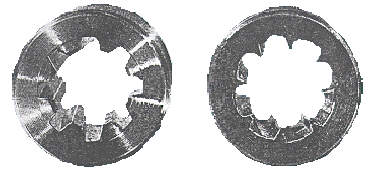Procedure to change from grease to oil in Joy 5048912 Lubricator
Application Temperature - Oil Grade Table
| Application | Temperature | Grade of Oil |
|---|---|---|
| All pnematic drills underground | -40° C to 0° C | EP20 to EP50 |
| Jackleg Stopers underground | -5° C to +20° C | EP100 |
| Drifter Drills underground all drills surface | +10 C to +30° C | EP150 |
| All pneumatic drills surface and underground | +30° C | EP220 |
PHQ recommends grades from EP20 up to EP50 rock drill oil when ambient temperature is between -40° and 0° C PHQ recommends EP100 as standard rock drill oil for hand held drills in most underground temperatures and applications. PHQ recommends EP150 rock drill oil at higher temperatures underground and for larger drifters underground. PHQ recommends EP150 as standard rock drill oil for use in all pneumatic drills in surface drilling applications. PHQ recommends grades from EP150 up to EP220 rock drill oil when ambient temperature exceeds 30° C
Drills damaged after being run on double zero (00) grease Always use lubricant supplied by the major oil companies such as: PETRO CANADA ESSO SHELL TEXACO
THESE PARTS WERE TAKEN FROM TEN JOY SAL60M STOPER DRILLS STRIPPED DOWN FOR EXAMINATION AFTER RUNNING ON DOUBLE ZERO (00) GREASE. A LONG LUBRICATION PORT IN FRONT ENDS of all the drills was PLUGGED WITH GREASE. there WAS HARDENED GREASE IN MANY OF THE DEAD SPOTS WITHIN THE DRILLS. ALL DRILLS REQUIRED MAJOR REPAIRS
CHUCK DRIVER SCORED AND WORN FROM LACK OF LUBRICATION IN FRONT END
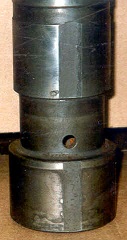
CHUCK INSERT WORN FROM LACK OF LUBRICATION IN FRONT END OF DRILL
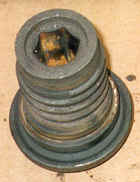
CHUCK PREMATURELY WORN OUT FROM LACK OF Lubrication in FRONT END.
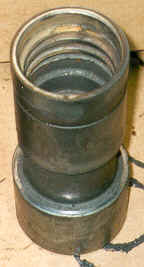
BACKHEAD OF THIS DRILL WAS FILLED WITH HARDENED GREASE. NO Lubrication was getting to the front end of this piston
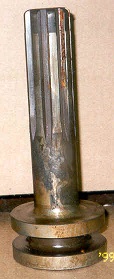
Notice the difference in the amount of mist coming from the drill using grease as compared to the amount of mist coming from the drill using oil.
Drilling with Grease Lubricant Consumption : 80ml/round Airborne Particulate : 0.06mg
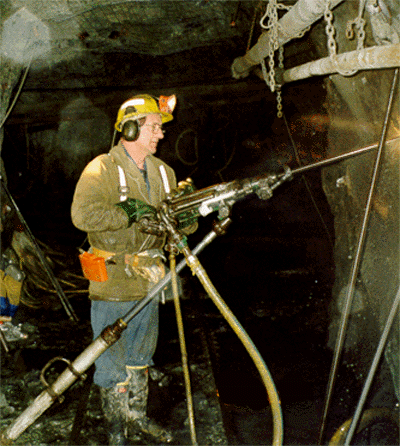
Drilling with Oil Lubricant Consumption : 325ml/round Airborne Particulate : 0.80mg
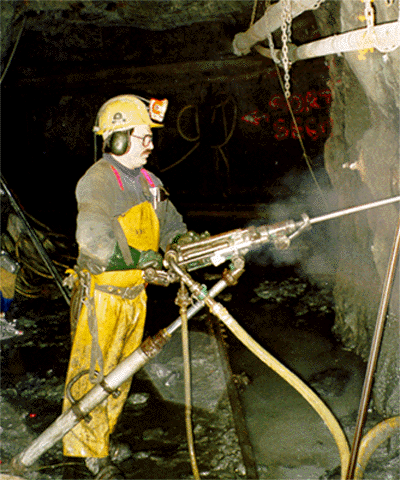
| Pro | Con |
|---|---|
| Grease adheres to metal better than oil so a corrosive resistant coating remains on parts in drills that are not used for long periods or kept in storage underground. | Grease which drips onto metal platforms (e.g.: scissor lifts & alimak raise machines) could produce slippery footing for operators. |
| Grease does not emulsify and will not wash out of drills, in instances where high water pressure causes a back-pressure and floods drills. | Grease does not readily wash off drill operators hands, face or out of their clothing. Drillers may complain of persistent smell of grease. |
| Grease does not "mist" as finely as rock drill oil, therefore is not as likely to be airborne in exhaust air coming from the drill. It is self evident from photographs that this is true and the point was proved by: Independent testing at CANMET's Experimental Mine | Grease does not travel up the hose as quickly as rock drill oil, so parts in the drills should be coated with grease before changing from rock drill oil to grease. This prevents lack of lubrication. (see procedures). |
| Grease consistency is thicker than the viscosity of rock drill oil. Molecules of grease are too large to dissolve in the bloodstream. | Studies have proven that the viscosity of rock drill oil is such that molecules of misted oil are too large to dissolve in the bloodstream. |
| When drills are "dieseling", rock drill oil is actually being burned in the drill, producing an oxidized gas which is unhealthy to breath. Grease will not "diesel". | In cold temperatures, heavy grease may not reach and lubricate the drill front end. Use the proper grade of grease suited to the temperature. (see procedures). (see what damage occurs if this happens) |
| Customers observed a reduction in wear of moving drill parts in preliminary testing. No overall improvement in parts wear proven. | If orifice setting in a HAL Lubricator is too large (Example: winter orifice used in summer) too much grease goes to the drill. It may fill or plug the valve chest slowing operation. JOY Lubricator requires no orifice change. |
| It is noted that double zero grease will collect and retain dirt and debris carried into the drill from rusted pipelines creating a grinding media to wear parts. | When rock drill oil washes out of the drill it carries with it most of the dirt and debris that may have blown into the drill from rusted pipelines. |
| It appears older drills, though nearly worn out have higher compression using grease and operate longer before major overhaul. | Use of grease does not increase penetration rates. Use of grease produces little or no reduction in rock drill noise levels. |
| Grease is very sticky in severe cold conditions. Grease can become tacky in drills stored in cold conditions and drills become hard to start. | Rock drill oil works in all weather conditions. Oil does not stick to parts in drills left in storage in cold conditions so drills start readily. |
| Notice less vibration in drills using grease. Observations not proven by measurement. Testing continues. | De-fatting solvents are used in manufacture of some greases. De-fatting solvents have a tendency to dry out human tissue. Exposed operators complain of dry skin. No de-fatting agents used in manufacture of Petro-Canada Vultrex EP000 grease. |
| Independent testing at CANMET's Experimental Mine has recorded a 75% reduction in consumption of lubricant in preliminary testing. |
| Description | IMPERIAL | METRIC |
|---|---|---|
| Capacity | 1 1/2 Pints | 700 ml |
| Length | 8 Inches | 200 mm |
| Diameter | 4 1/2 Inches | 115 mm |
| Weight Empty | 8 Pounds | 3.5 kg |
| Weight Full | 12 Pounds | 5.5 kg |
| Pressure Rated (Operating Max) | 250 psi | 17 kg/cm3 |
| Safety Fill Cap Diameter | 1 7/8 Inches | 48 mm |
| Pressure Tested to Destruction | 1200 psi | 85 kg/cm3 |
| Pipe Thread Size at Intake or Outlet | 1 1/4 Inches | 1 1/4 Inches |
| Bushing Sizes Available | 1 1/4 Inches to 1 Inch or 3/4 Inch | 1 1/4 Inches to 1 Inch or 3/4 Inch |
Joy lubricators were pressure tested to destruction and required internal pressures exceeding 1200 psi before cracks began to appear in castings. Even at extreme pressure the cracks which appear simply release internal pressure without exploding the lubricator. The safety filler cap warns when opening the Lubricator under pressure. The Joy Lubricator has been thoroughly tested and found to be a safe pressure vessel. Recommended for use with quality rock drill oil or triple zero (000) rock drill grease.
It is a fact that lack of lubrication is the leading cause of failure of most equipment.
Lack of lubrication can be prevented by :
Evidence of Lack of lubrication:
Front End:
Burnt piston removed from a siezed rock drill following a severe lack of lubrication. The end broke off the piston and the rock drill cylinder from this drill was ruined, and had to be scrapped. Picture Courtesy of Ingersoll-Rand
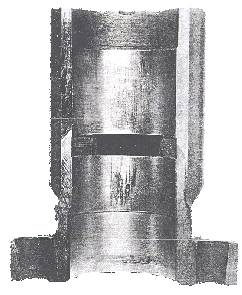
Piston:
Cut-away view of a front end from a hand held rock drill showing excessive scoring and marking from abrasive wear following a lack of lubrication. The front end was scrapped. Picture Courtesy of Ingersoll-Rand
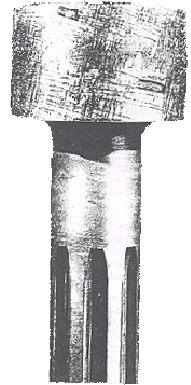
Rifle Bar:
Close up view of splines of a rifle bar taken from a rock drill run without lubrication. Notice the prominent tell-tale transverse cracks running across splines of the rifle bar. The rifle bar broke in half, and was replaced. Picture Courtesy of Ingersoll-Rand
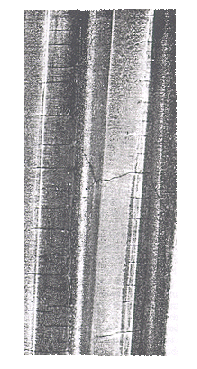
Rifle Nuts:
A new rifle nut (on the left) compared with the rifle nut from a drill run with little or no lubrication (on the right). It only takes a few minutes without lubrication to do this kind of damage. Picture Courtesy of Ingersoll-Rand
